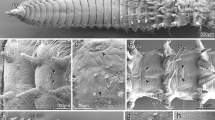Abstract
Numerous ‘genital’ papillae are described for the first time in the freshwater miteHydrovoliza placophora. In contrast to other actinotrichid mites, these organs are located on the epimeral plates, thus well removed from the genital opening. Ultrastructurally, the papillae correspond to those of other freshwater mites and are thus likely involved in ion/osmoregulation.
Similar content being viewed by others
References
Alberti, G., 1977. Zur Feinstruktur und Funktion der Genitalnäpfe beiHydrodroma despiciens (Hydrachnellae, Acari) Zoomorphology, 87: 155–164.
Alberti, G., 1969. Fine structure and probable function of genital papillae and Claparède organs of Actinotrichida. In: J. Rodriguez (Editor), Recent Advances in Acarology, Vol. II. Academic Press, New York, pp. 501–507.
Barr, D., 1982. Comparative morphology of the genital acetabula of aquatic mites (Acari, Prostigmata): Hydrachnoidea, Eylaiodea, Hydrophantoidea, and Lebertioidea. J. Nat. Hist., 16: 147–160.
Bartsch, I., 1973.Porohalacarellus alpinus (Thor) (Halacaridae, Acari), ein morphologischer Vergleich mit marinen Halacariden nebst Bemerkungen zur Biologie dieser Art. Entomol. Tidskr., 94: 116–123.
Cook, D.R., 1974. Water mite genera and subgenera. Mem. Am. Entomol. Inst., 21: 860 pp.
Fashing, N.J., 1984. A possible osmoregulatory organ in the Algophagidae (Astigmata). In: D.A. Griffiths and C.E. Bowman (Editors), Acarology VI (1). Ellis Horwood, Chichester, pp. 310–315.
Grandjean, F., 1938. Observations sur les Bdelles (Acariens). Ann. Soc. Entomol. France, 107: 1–24.
Grandjean, F., 1969. Stases. Actinopiline. Rappel de ma classification des Acriens en 3 groupes majeurs. Terminologie en soma. Acarologia, 11: 796–827.
Kethley, J., 1982. Acariformes. In: S.P. Parker (Editor), Synopsis and Classffication of Living Organisms, Vol. 2, McGraw Hill, New York, pp. 117–145.
Komnick, H., 1977, Chloride cells and chloride epithelia of aquatic insects. Int. Rev. Cytol., 49: 285–329.
Krantz, G.W., 1978. A Manual of Acarology (2nd edition). Oregon State University Bookstores, Corvallis, 509 pp.
Lindquist, E.E., 1984. Current theories on the evolution of major groups in Acari and on their relationships with other groups of Archnida, with consequent implications for their classification. In: D.A. Griffiths and C.E. Bowman (Editors), Acarology VI (1). Ellis Horwood, Chichester, pp. 28–62.
Monti, R., 1905. Über eine kürzlich entdeckte Hydrachnide (Polyxo placophora R. Monti n.g.n. sp.,Hydrovolzia halacaroides Sig Thor n.g.n. sp.). Zool. Anz., 28: 832–838, pl. 1–2.
Olomski, R., 1986. Die Osmo- und Volumenregulation der SüßwassermilbeLimnesia maculata (O.F. Müler, 1776) (Acari: Hydrachnidia). Verh. Dtsch. Zool. Ges.,79: 315–316.
Olomski, R., 1988. The evolutionary transofrmation of osmotic regulation in the life cycle of fresh water mites (Acari: Hydrachnidia). In: P.W. Murphy and R. Schuster (Editors), The Acari: Reproduction, Development and Life-History Strategies. Chapman and Hall, London (in press).
Phillips, J.E., 1983. Cellular mechanisms and control of excretion in insects. Recent advances. Verh. Dtsch. Zool. Ges., 78: 55–68.
Thor, S., 1905. Eine interessante neue Milbengattung aus der schweizerischen Sammlung des Herrn Dr. W. Volz. Zool. Anz., 28: 505–509.
Van der Hammen, L., 1969. Notes on the morphology ofAlycus roseus C.L. Koch. Zool. Mededel.,43: 179–202.
Van der Hammen, L., 1980. Glossary of Acarological Terminology. I. General Terminology. Dr. W. Junk, The Hague, 244 pp.
Vercammen-Grandjean, P.H., 1975. Les organes de Claparede et les papilles genitales de certains Acariens-sont-ils des organes respiratoires? Acarologia, 17: 624–630.
Viets, K., 1936. Wassermilben oder Hydracarina (Hydrchnellae und Halacaridae). In: F. Dahl (Editor), Die Tierwelt Deutschlands, parts 31 and 32.
Walter, C., 1922. Die Hydracarinen der Alpengewässer. Denkschr. Schweiz. Naturforsch. Ges., 58: 251 pp.
Author information
Authors and Affiliations
Rights and permissions
About this article
Cite this article
Alberti, G., Bader, C. Fine structure of external ‘genital’ papillae in the fresh water miteHydrovolzia placophora (Hydrovolziidae, Actinedida, Actinotrichida, Acari). Exp Appl Acarol 8, 115–124 (1990). https://doi.org/10.1007/BF01193386
Accepted:
Issue Date:
DOI: https://doi.org/10.1007/BF01193386




